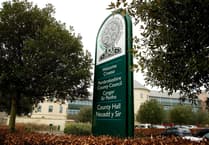Plans to convert former hunt kennels to a dwelling at a listed 17th century Pembrokeshire mansion, built by the descendant of one of Henry VII’s supporters, have been approved.
In an application before Pembrokeshire County Council planners, Stephen Davies sought permission for the conversion of the former kennels at the Grade-II*-listed Glandovan Mansion, Cilgerran, to a three-bed dwelling, along with the demolition of sections of wall beyond repair, the plans themselves a change to a 2018 scheme previously approved.
A supporting statement through agent Mark Waghorn Architects Ltd said: “Glandovan is a substantial double-pile gentry house of c. 1670 with earlier origins, partly remodelled and extended in 1832,” adding: “The kennel building, the only survival of a long ruined small farmyard, is within the historic curtilage of the stable court and is therefore of listed status. The proposal seeks to reintegrate the former farmyard into the estate through refurbishing and reinterpreting the building as a dwelling.”
It says the previous application proposed the removal of an 150-200-year-old oak tree that has grown into the western stone wall, but it is now planned to “retain this tree as a vital piece of history at Glandovan,” adding: “The design, therefore, considers how the kennels can be developed in a way that causes minimal disturbance to the oak tree and its root network.”
It says the history of Glandovan can be traced back to the Vaughan family, William Vaughan a supporter of Henry VII, gaining the title of Lord of Cilgerran, later Constable of Cilgerran Castle before a descendant built the house, which later passed through many owner before coming under the tenancy of Walter Frank Corbett in the early 20th century.
Referring to the former kennels, previously a ‘cow house’ it adds: “During the tenancy of Walter Frank Corbett, the horses and hound pack of the Tivyside Hunt were kept at Glandovan. The Carmarthen Journal of March 7, 1913 reported that under the mastership of W Roch of Plas-y-Bridell, ‘extensive alterations’ were to be made at Glandovan to provide suitable accommodation.”
An officer report recommending approval, said: “The existing structure, albeit it is in a state of disrepair, is an important building and adds to the range of buildings associated with Glandovan country house. This Grade-II*-listed country house, with its associated buildings, is amongst the most important architectural and historic buildings in the country.”
The application was conditionally approved.




